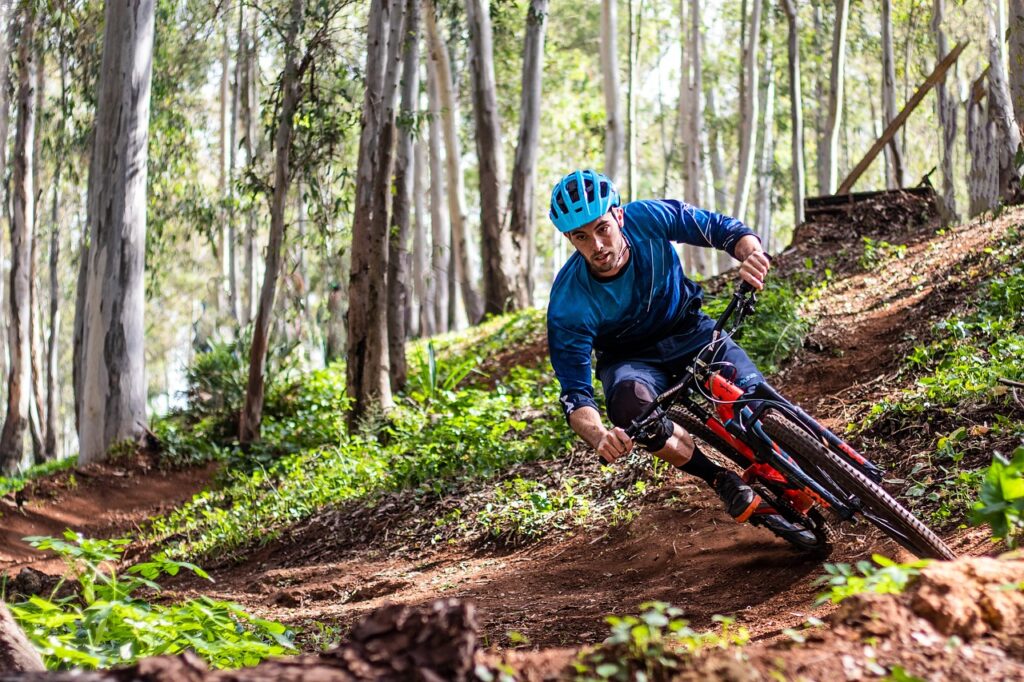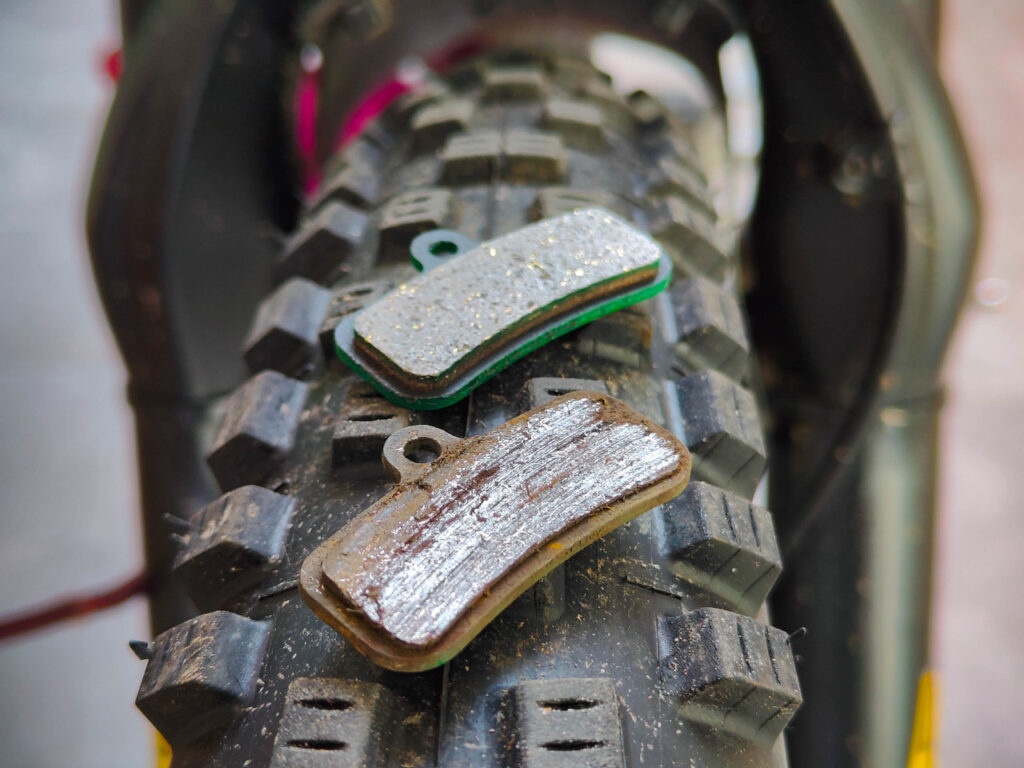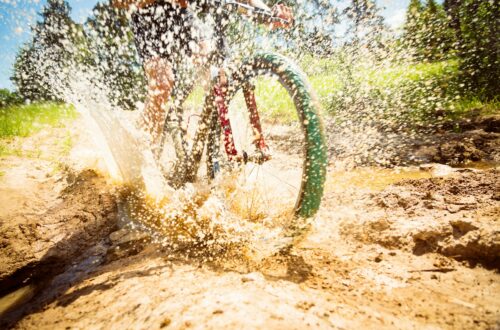
How Long Do Mountain Bike Brake Pads Last?
The brake pads on your mountain bike play a very important roll in providing great stopping power. Understanding the lifespan of a brake pad is vital for a safe and enjoyable ride. But how long do mountain bike brake pads last?
On average, brake pads on a mountain bike last 300-800 miles (500-1300 km). The main factors that affect the lifespan are: riding style, riding conditions, brake bedding, brake pad material and maintenance. A sintered brake pad has the longest longevity; an organic pad the shortest.
In this article, we’ll delve into the world of brake pads. We’ll talk about the different types of brake pads, the factors that determine their lifespan, how long they last and how to get the most out of them.
Types Of Mountain Bike Brake Pads
Brake pads for mountain bikes come in a variety of shapes, sizes and compounds. When buying new ones, it is important to make sure that you have the right pads for your brake caliper. Brake pads are produced by the manufacturer of the caliper, and there are also aftermarket alternatives. Take out your worn pad to compare the shape or look for a part number.
Within brake pads for mountain bikes, there are three options in compound: sintered/metallic, organic/resin and semi-metallic. Sintered pads offer great stopping power but are noisy and hard on the brake discs. Organic pads are the quietest but have a shorter lifespan. Semi-metallic sits in between.
You can read more about friction and heat development for sintered, organic and semi-metallic pads, in this article.
| Sintered | Organic | Semi-Metallic | |
| Performance | Great stopping power and heat resistant. Little chance of glazing | Smooth, quiet braking, good modulation. Chance of glazing | Balance between smooth modulation and durability. Chance of glazing |
| Durability | Very durable but hard on brake discs | Wears out fast, especially in muddy conditions | Less durable than sintered pads |
| Suitable for | eMTB, enduro, downhill and muddy conditions | Road bikes, cross-country. Works best in warmer climates | Cross-country and wet conditions |
Sintered/Metallic
Sintered (also metallic) brake pads are made out of a mixture of metal particles bonded together. The material is hard, durable and offers great stopping power. It is also heat resistant which reduces the chance of brake fade. Sintered pads are ideal for the more aggressive forms of mountain biking like electric mountain biking, enduro or downhill.
The downside of the sintered pads, is that the harder material makes your brake discs wear faster. They are also quite noisy and they take more time to warm up.
Organic/Resin
The organic (also resin) brake pad, is the alternative which offers the most comfort. It is made out of a mix of rubber, glass, fiber, and is bonded together with resin. In comparison to the sintered pads, the material is softer. They deliver a smooth and quiet braking experience with good modulation. Together with semi-metallic pads, organic brake pads are the best option for the less aggressive forms of mountain biking like cross-country (XC).
The disadvantage of the organic brake pads, is that the softer compound wears out faster, especially in muddy conditions. They are not as hard on brakes discs, but will need replacing sooner. The material has an insulating effect, which keeps the temperature within the brake rotor. Although they won’t transfer heat to your brake fluid, the pads can get hot and glaze over during heavy braking.
Semi-Metallic
The semi-metallic brake pad is an all-rounder and sits between the sintered and the organic brake pad in all areas. In terms of material, it’s a blend of metallic fibers and organic material. They offer good stopping power, have decent modulation and warm up quicker than sintered pads. Often they are used on cross-country (XC) mountain bikes.
The downside of the semi-metallic pad, is that it can be prone to glazing. It is also the most expensive pad out of the three.
Factors Affecting Brake Pad Lifespan
We can all understand that the most obvious factor that determines how long brake pads last, is riding style. Modulate braking in comparison to aggressive braking, will wear them out less quickly. Knowing the factors affecting brake pad lifespan helps you get the most out of them!
The main factors that determine the lifespan of brake pads on a mountain bike, are: riding style, riding conditions, brake bedding, brake pad material and maintenance.
Riding Style
An aggressive riding style is a lot of fun, but it is also hard on your brake pads (and discs). Frequent and hard braking puts a lot of stress on the pads. As a result, the pads get hot which accelerates the wearing process even more. Too much heat in the braking system can reduce friction and thus stopping power. This phenomenon is called: brake fade.

Riding Conditions
Dust, sand an mud are a common occurrence in mountain biking. When getting in contact with your braking system, they acts like sandpaper which increases wear and tear of the system.
Rainy conditions have the exact opposite effect: water reduces friction and makes the braking action less effective. In order to stop in time, the rider needs to brake harder en put more stress on the pads.
The Bedding In Process
Bed in new brake pads is actually a pairing process between the pad and the disc (or rotor). A new disc has pores and grooves on the braking surface. When you bed in new pads with that disc, a small amount of pad material fills up those pores which will create more grab and friction between the two surfaces. If not done correctly, you get an uneven deposit of pad material which can result in brake judder, noisy brakes and a shortened lifespan.
To bed in new brake pads, you should follow this procedure: find a slight hill and roll at 10 mph. Now brake firmly and bring the bike to a nearly stop. Repeat this 4 to 5 times and you’ll feel the stopping power increase. Repeat this process one more time at 15 mph, and your brakes are bedded in!
Dragging the brakes over a longer distance does not have the same result as the procedure above. The pads will overheat which causes them to glaze.
It’s now clear why switching to a different brake pad material on the same disc brake, is a bad idea. You should then also replace the brake disc. If you switch the pads with replacements of the same compound, the advise is to use fine grit sandpaper to roughen up the brake disc surface.
Brake Pad Material
There are three compounds to choose from: sintered (metallic), organic (resin) and semi-metallic. Picking the right material affects the lifespan dramatically. For the more aggressive forms of mountain biking like enduro, eMTB and downhill, you’re best off with the harder sintered pads. The softer pads like organic and semi-metallic are great for cross-country and trail as these sports are easier on the brakes.
Brake Maintenance
Maintaining your braking system is often overlooked. Not being able to detect issues with your braking system is a huge safety hazard. Regular cleaning and inspection is a form of maintenance which keeps you up to date of the condition of your brake system. Acting on any sign of a problem will lengthen a pads life and save you money in the long run.
More about this subject later in this article.
How Long Do Mountain Bike Brake Pads Last?
We’ve established that there are quite a few factors that determine how long a brake pad on a mountain bike lasts. This doesn’t make it easy to give an estimation. But based on personal experience, it is possible to give an indication about their lifespan.
Roughly knowing the interval for replacing your brake pads, tells you whether you’ve got the right brake pads for the job and makes it easier to implement brake maintenance in your maintenance schedule. If you know how many miles you ride per year, you know how many brake pads you’ll need.
The best way of providing an estimated lifespan, is to do it per pad compound.
| Compound | Works well with | Expected lifespan |
| Sintered/Metallic | Under all conditions, eMTB, enduro and downhill | 500-1000 miles / 1800-1600 km |
| Semi-metallic | Wet and dry conditions, cross-country | 300-800 miles / 500-1300 km |
| Organic/Resin | Dry conditions, road bikes, and less extreme cross-country | 200-600 miles / 300-1000 km |
When Should You Replace Your Brake Pads?
You can determine whether your brake pads are worn, by measuring the thickness and looking at the braking surface. The minimum thickness can be found on the pad itself and is usually around 3 mm. If the surface of the pad is shiny, the pads most likely got too hot and will also need replacing.

The shiny surface on your brake pads, is a sign of a pad that got too hot too quickly. This is called glazing and can be a result of a poorly executed bedding in process. If that’s not the case, you might want to consider switching to a harder compound or adapt your riding style. There are tricks to remove the hardened, glassy surface off a brake pad, but replacing the pads is the safest option!
When you’re inspecting the brake pads, the advise is to also have a look at the brake discs. An overly shiny surface can also happen to your brake disc. If this is the case, just replacing the brake pads will not improve your braking performance and will cause your new pads to wear out quicker. To recondition the disc, you can sand down the shiny surface with fine grit sand paper.
Also check your braking system for leaks as brake fluid on your discs and pads reduces friction and decreases stopping power. Try to avoid touching either the braking surface of your brake pads and disc. Degrease your brake disc before putting it all back together and make sure the pads are aligned properly!
Ways To Increase Brake Pad Lifespan
The best ways to increase the lifespan of a brake pad on the bike, is to properly bed new brakes in, use brake modulation and choose the right compound. Off the bike, you should inspect, maintain and clean your braking system often.
If you are still experiencing fast wearing brake pads, your brakes might be too weak for your riding style and the terrain you conquer. You can upgrade your braking system by fitting larger diameter brake discs and calipers with more pistons. Do research online or visit your local bike shop to confirm that an upgrade is possible for your bike.
Frequently Asked Questions
Sintered brake pads have the longest lifespan because of the harder compound. But as a result, your brake discs lifespan shortens. So sintered brake pads don’t make your braking system more durable.
Bigger brake discs (rotors) will increase braking torque and therefore stopping power. Too much braking torque causes the wheel to skid. This reduces friction which increases stopping distance.
The best way to prevent fading of brakes, is to modulate brake pressure. Dragging brakes for the complete length of a descent, can cause them to overheat.
Electric mountain bikes are heavy and powerful. You should use sintered or semi-metallic pads as they are the most durable and less prone to overheating.





